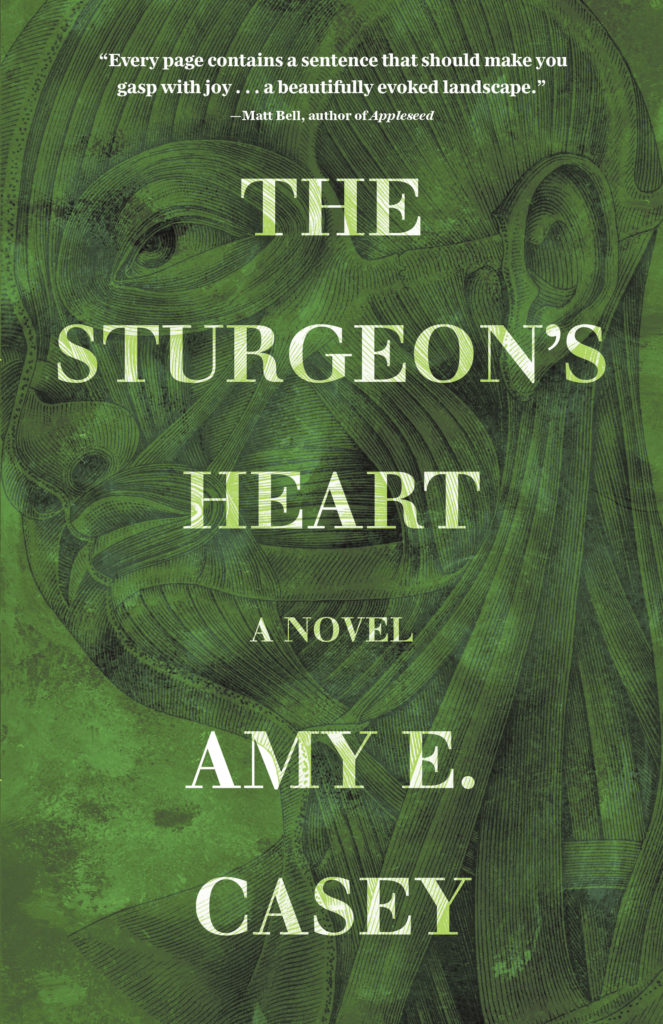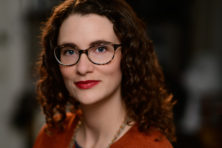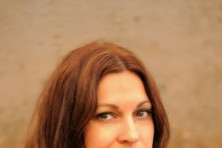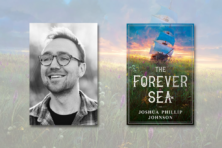Questions & Authors: Amy E. Casey
- Share
- Tweet
- Pin
- Share

As we head into autumn and the spooky season, I start to reach for books that really give me fall vibes – essentially things that are very atmospheric. I kicked off my fall reading with The Sturgeon’s Heart by Amy E. Casey. I learned about this title through Novel Bay Booksellers in Sturgeon Bay, which hosted Casey this summer.
Her debut novel is a Midwestern monster story reminiscent of gothic literature, and her floral prose creates landscapes that feel familiar to the reader while introducing Duluth and Lake Superior to those who are unfamiliar with the area.
Three people in the same northern city of Duluth, Minnesota, are vanishing in different ways: Howard Wright finds his skin turning transparent, revealing the bloody workings of musculature beneath. Sarah Turnsfield is living under an assumed identity, on the run from her past as a meteoric scientific prodigy. Jo Breckmier seeks a new start in Duluth after a bitter divorce. On one remarkable night along the rugged shore of Lake Superior, the lines between reality and legend intersect, and identities are broken and remade.
I talked with Casey about The Sturgeon’s Heart, the publishing process and what’s next for her.
This interview has been edited for clarity.

Grace Johnson (GJ): To start off, tell me about yourself!
Amy Casey (AC): I am a Wisconsin native, born in Milwaukee, and I have lived in Wisconsin all of my life. I feel that my Midwestern roots definitely show themselves in my work.
GJ: Was writing a part of your life growing up? Did you anticipate trying to become a writer?
AC: It’s definitely been a dream of mine to publish a book. I spent 13 years as an English teacher in the public high school system. When I got my master’s in education, I was able to participate in some graduate courses that were creative-writing focused, and it was there, being surrounded by these incredible people who were pursuing poetry PhDs, that I really got the momentum.
As a kid, I would take this little purple notebook with me everywhere, like trips to the park or down to the lake, and I would scribble down my adventures as if I were some kind of explorer or hero.
GJ: How would you describe your writing style, and how did you develop that style?
AC: I think my style is influenced by what I enjoy reading. I have consumed a lot of monster stories over the course of my life, and I’ve always really been influenced by that kind of sci-fi/fantasy genre, but also the literary side of things. I feel like my style kind of brings together those two worlds of the literary and more surrealist, fantasy style.
That definitely is a mainstay in my work: trying to represent the world realistically and faithfully, but also having that sense of magic still intact.
GJ: Where did you get the inspiration for The Sturgeon’s Heart?
AC: The inspiration really came from a sense of place. The novel is set in Duluth, on the north shore of Lake Superior. My mom’s side of the family comes from that area. When I was thinking about writing a book, I was thinking about setting – for me, setting is always first – and what is the most powerful place for me.
My first inklings of what the book would be about happened about six years ago, and making Howard the main character. I really wanted to work with something or somebody who could be in that monster category but also be very human. I started brainstorming what that might look like – almost a modern-day Frankenstein idea.
GJ: As you mentioned, your style is a combination of realism and surrealism. In The Sturgeon’s Heart, that surrealist element is done with a light touch. Independent from that, this story still would have worked well without that component. What prompted you to want to dive into that and make it a central part of the story?
AC: I wanted to write a story where both science and magic could be real simultaneously, and I was thinking a lot about the idea that things happen when we’re not looking.
I also did a lot of reading about the concept of the wild man. In earlier times, before we had the internet, and as colonists were moving their way across the U.S., there were these people on the fringes of society, and there were all kinds of legends about them.
Most of all, I really wanted to create what, at least to me, is a meditation on fear. I think fear is the monster that we all believe in. Fears about our bodies, our minds, our hearts. The three characters – Howard, Jo and Sarah – are representative of that monster and what it can do to you, and how to potentially befriend it, live with it or confront it.
I think that magic is the perfect metaphor for that, and I think it’s something that is as ancient as storytelling itself.
GJ: There are a lot of great stories like yours that mirror nature with human nature. How do you see those two connecting?
AC: I think that the human experience and the natural world are so fundamentally intertwined. I was thinking a lot about how there are always private struggles happening in nature, even below our feet. There’s an insect living or dying as we’re walking along, and we have no concept of it, and I think that really mirrors the experience of being a person, too.
We all have these private desires, fears and struggles that only we can know, and I think that observation of the natural world can be a way to understand that and meditate on that. It was important for me that there is this sense of inevitability. Just as a tree has to shed its leaves in the fall or a sturgeon has to go upstream to spawn, we all have paths of our lives that become inevitable in time as we fulfill our destiny.
I wanted the setting to be able to almost be a character: that nature is bearing witness to what we experience, even when other people don’t know what we’re going through. The Earth is always here, listening, bearing witness and providing the setting for these dramas to play out.
GJ: This isn’t really a question, but more of a statement. I feel like all the stories come to a conclusion, but I wouldn’t call the ending of this a happily-ever-after.
AC: I think it goes back to what we were just talking about before: how I wanted the natural world and these characters’ struggles to be deeply intertwined. Nature is an impartial observer; there’s no good or evil.
I wanted it to feel like the experience people have when they face down their fears. We don’t always win, and sometimes we win by losing. It’s not always this neat bow, and there are things that we can never anticipate that help to shape who we are.
I wanted the ending to mirror that authenticity of both life and the natural world – that things grow and progress organically in unanticipated ways.
GJ: What was the editing and publishing process like for you?
AC: It was so wonderful. I’m published through an independent publisher called Gibson House Press, and they are a traditional press, but small and intimate enough that I got to be really involved in things an author with a bigger publisher would not necessarily have input in – so the title, cover design and talking about fonts, which I’m very passionate about.
For editing, we did several passes throughout the process of getting the book ready for publication. My editor, Deb, is extremely incisive and skilled at being able to say this scene is ready, the scene is tight, we need to clarify this, etc.
She and I were a wonderful match and actually completed the whole process virtually because my book was discovered in the depths of COVID-19 in 2020. Our whole process happened over phone calls, Zoom calls and the internet, and I met her for the first time this past June.
Feedback makes writing better at all levels for all people, and to see it in the professional publishing world was really thrilling for me.
GJ: Did this back-and-forth process help illuminate anything for you or change the direction of your story?
AC: It’s typically a more collaborative process with an independent publisher. As a writer, you get deeply attached to this project that has dominated your life, for years perhaps, and I loved being able to discuss certain moments or images and weigh their value.
It’s so hard when you’re the person who’s created something to see the big picture, and I deeply appreciated my editor’s vision of being able to zoom out and see the book as a whole, and understand where we could tighten a thread here or maybe cut some dead weight there to make sure that it was the best final product it could be.
GJ: That’s good to hear! I’m always curious about the relationship between writer and editor. There are a lot of mixed feelings on that topic.
AC: I think part of it is also your relationship with yourself as a writer – getting comfortable enough to accept that what you created may not be perfect.
Ultimately, you want a reader to be able to see your vision. It’s wonderful when you can have a collaborator who helps shepherd that vision into being instead of trying to alter it or manhandle it into something that is more sellable or who knows. I felt like my editor really had the original vision of the story in her heart and mind as we were working together.
GJ: I saw that you write on a typewriter. Is that all versions? What’s your writing process?
AC: The manual typewriter is the greatest invention ever, and I will live and die by that. I use it only for first-draft material. I definitely edit, revise and proofread via digital means.
What I love about the typewriter for the initial drafting is there is no internet access; there is no Delete key. So you can’t write two sentences, delete them, write two sentences, delete them – the only way to move is forward. You get this delightful biofeedback from the sensation of hitting the keys, and every time you reach the end of the line, you get the little “ding,” and it’s like a reward!
I’m very ritualistic in my habit building. It helps to know that when I sit down at the typewriter, it is a writing machine as opposed to my computer, which is an everything machine. I do my banking on that; I don’t need that energy around me when I’m trying to create.
So you’re with the writing machine; you light your candle; you have your latte or wine or water – whatever your preferred hydration is; and it helps set the stage for your brain.
For me that’s the only way I have any success: by reserving time and then completing that ritual. Also committing to the time whether or not I have an idea – just writing and seeing what happens.
GJ: Speaking of writing, are you working on anything new?
AC: I am currently working on my second novel. It’s a stand-alone.
It’s still in the early stages, but it will be familiar in the sense that it will still have surrealistic elements set in a realistic universe, but the setting is totally different. It is going to be urban this time.
GJ: What are you currently reading, or what would you recommend that everybody read?
AC: I just finished the second book in Benjamin Percy’s Comet Cycle, The Unfamiliar Garden. It’s a series about what happens when a comet hits the Earth and introduces a whole lot of chaos into the way things are. I also recently read a nonfiction book, Deep by James Nester. It’s about free diving and the human body and how it interacts with water at depth.
In general, what I would recommend people read – I certainly have my favorites, but my definite standby answer is, whatever they love.
I think there is way too much snobbery out there in the reading world: “This is good” or “That is trash” or “I can’t believe you’re reading that.” I think that reading is one of the great pleasures in life, and if you like a trashy romance novel, by all means, lean in. Whatever brings you pleasure is what you should be reading.



